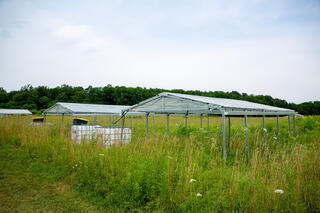Drought, heat reduce switchgrass yields and inhibit fermentation

Objective
To determine if water limitation affects switchgrass biomass yields and yeast fermentation.
Approach
Researchers used rainout shelters to induce low soil moisture on five marginal land sites planted with switchgrass across a latitudinal gradient in Michigan and Wisconsin during the 2018-2021 growing seasons. Paired switchgrass in replicate plots was exposed to 60% rainfall exclusion under shelters in 2018 with switchgrass exposed to normal rainfall as control. This was followed by 100% rainfall exclusion in 2019-2021.
Switchgrass was pretreated using ammonia fiber expansion followed by high solids enzymatic hydrolysis. Hydrolysates were fermented using engineered Saccharomyces cerevisiae, and real-time carbon dioxide and final ethanol production measured to compare yields of water-stressed crops against those grown in ambient conditions.
Results
Rainout shelters did not simulate severe drought nor reduced biomass yields in 2018 yet led to reduced fermentability at the Hancock site with Entisol soil type. Complete rainfall exclusion further affected the biomass yields in 2019-2021 and fermentability. Structural modifications to the rainout shelters reduced biomass yields at sites with Alfisol and Entisol soils in later years. Water stress during switchgrass growth caused by the soil type may affect the yeast fermentability, which may not be evident through initial evaluation of upstream biomass metrics such as biomass yield, composition, and digestibility.
Impact
As bioenergy crops should not compete with arable land use for food production, these species are expected to be tolerant to conditions that render lands unsuitable or unprofitable for food crops, such as limited soil water availability during the growing season. These results expose some of the challenges associated with producing biofuels from lignocellulosic biomass grown under drought conditions.